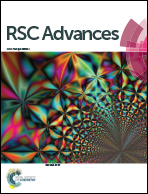Preparation of structurally colored films assembled by using polystyrene@silica, air@silica and air@carbon@silica core–shell nanoparticles with enhanced color visibility†
Abstract
Polystyrene@silica (PS@SiO2) core–shell nanospheres were synthesized using a surfactant free method followed by a modified Stöber method in the research reported in this paper. Hollow SiO2 was obtained by calcining the PS@SiO2 core–shell nanoparticles (NPs) at 500 °C in air and air@C@SiO2 (where C represents carbon) was prepared by calcining PS@SiO2 in argon (Ar). Scanning electron microscopy and transmission electron microscopy were used to confirm the formation of a homogeneous SiO2 shell on the negatively charged PS beads. Energy dispersive X-ray spectroscopy element mapping was utilized to confirm the existence and homogeneity of the C layer in the air@C@SiO2 nanospheres. After calcination, C partly remained inside the SiO2 shell and functioned as an absorbent material. The advantages of using negatively charged PS beads to prepare PS@SiO2 core–shell NPs and calcination of PS@SiO2 in Ar to prepare hollow SiO2 are: (1) the lower cost compared with the positively charged PS beads, because the negatively charged PS beads could be obtained by using cheap anionic initiators (such as potassium persulfate); (2) the color saturation of the photonic crystals (PCs) composed from hollow SiO2 is significantly enhanced without disturbing the PCs arrays when the calcination process is carried out in Ar. Hollow SiO2 PCs with enhanced color saturation will enrich the application of core–shell structures in many fields such as bionic colors, paintings, cosmetics, and photonic papers.


 Please wait while we load your content...
Please wait while we load your content...